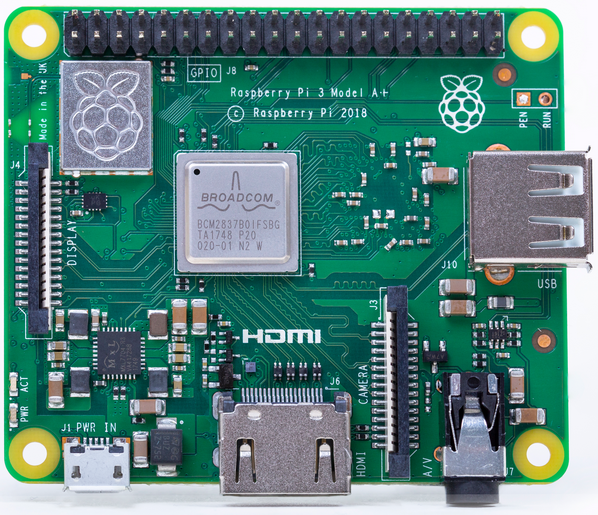This is the base Nerves System configuration for the Raspberry Pi 3 Model A+ with the USB port running in gadget mode.
| Feature | Description |
|---|---|
| CPU | 1.4 GHz quad-core ARM Cortex-A53 |
| Memory | 512 MB DRAM |
| Storage | MicroSD |
| Linux kernel | 4.19 w/ Raspberry Pi patches |
| IEx terminal | OTG USB serial port (ttyGS0). Can be changed to HDMI or UART. |
| GPIO, I2C, SPI | Yes - Elixir Circuits |
| ADC | No |
| PWM | Yes, but no Elixir support |
| UART | 1 available - ttyAMA0 |
| Display | HDMI or 7" RPi Touchscreen |
| Camera | Yes - via rpi-userland |
| Ethernet | No |
| WiFi | Yes - Nerves.Network |
| Bluetooth | Not supported yet |
| Audio | HDMI/Stereo out |
The Raspberry Pi 3 Model A+ is supported by the official nerves_system_rpi3, but the USB port is configured to work as a host only. This Raspberry Pi can be connected directly to your computer via a USB cable like the Raspberry Pi Zeros. To do this, you'll need a USB A to USB A connector like this or this.
The most common way of using this Nerves System is create a project with mix nerves.new and to add this system as a dependency in your mix.exs:
defp system("rpi3a"), do: [{:nerves_system_rpi3a, github: "nerves-project/nerves_system_rpi3a", runtime: false}]If you add it like that, then make sure you to export MIX_TARGET=rpi3a when you
build. See the Getting started
guide
for more information.
If you need custom modifications to this system for your device, clone this repository and update as described in Making custom systems
If you're new to Nerves, check out the nerves_init_gadget project for creating a starter project. Raspberry Pi Zero projects should work with this Nerves system except faster. Make sure to update the target dependency
The base image includes drivers for the onboard Raspberry Pi 3 A+ wifi module
(brcmfmac driver).
The Raspberry Pi has many options for audio output. This system supports the HDMI and stereo audio jack output. The Linux ALSA drivers are used for audio output.
To try it out, run:
:os.cmd('espeak -ven+f5 -k5 -w /tmp/out.wav Hello')
:os.cmd('aplay -q /tmp/out.wav')The general Raspberry Pi audio documentation mostly applies to Nerves. For example, to force audio out the HDMI port, run:
:os.cmd('amixer cset numid=3 2')Change the last argument to amixer to 1 to output to the stereo output jack.
If you need better real-time performance from the Linux kernel, the preempt_rt
patch set may help. Be aware that we do not test with the patches so this may
not work. To enable it, make a custom system using this one as a base and add
the following to the nerves_defconfig:
BR2_LINUX_KERNEL_PATCH="http://cdn.kernel.org/pub/linux/kernel/projects/rt/4.19/patch-4.19.25-rt16.patch.xz"
Please verify the patch version since these instructions may be out-of-date.
Next, update the Linux configuration to use it. Review the Nerves documentation
for running make linux-menuconfig and enable PREEMPT_RT_FULL. Alternately,
make the following change to the Linux configuration:
-CONFIG_PREEMPT=y
+CONFIG_PREEMPT_RT_FULL=y
Build the system and you should now have a preempt_rt kernel.
This system supports storing provisioning information in a small key-value store outside of any filesystem. Provisioning is an optional step and reasonable defaults are provided if this is missing.
Provisioning information can be queried using the Nerves.Runtime KV store's
Nerves.Runtime.KV.get/1
function.
Keys used by this system are:
| Key | Example Value | Description |
|---|---|---|
nerves_serial_number |
"12345678" |
By default, this string is used to create unique hostnames and Erlang node names. If unset, it defaults to part of the Raspberry Pi's device ID. |
The normal procedure would be to set these keys once in manufacturing or before deployment and then leave them alone.
For example, to provision a serial number on a running device, run the following and reboot:
iex> cmd("fw_setenv nerves_serial_number 12345678")This system supports setting the serial number offline. To do this, set the
NERVES_SERIAL_NUMBER environment variable when burning the firmware. If you're
programming MicroSD cards using fwup, the commandline is:
sudo NERVES_SERIAL_NUMBER=12345678 fwup path_to_firmware.fwSerial numbers are stored on the MicroSD card so if the MicroSD card is replaced, the serial number will need to be reprogrammed. The numbers are stored in a U-boot environment block. This is a special region that is separate from the application partition so reformatting the application partition will not lose the serial number or any other data stored in this block.
Additional key value pairs can be provisioned by overriding the default
provisioning.conf file location by setting the environment variable
NERVES_PROVISIONING=/path/to/provisioning.conf. The default provisioning.conf
will set the nerves_serial_number, if you override the location to this file,
you will be responsible for setting this yourself.
There's a subtle coupling between the nerves_system_br version and the Linux
kernel version used here. nerves_system_br provides the versions of
rpi-userland and rpi-firmware that get installed. I prefer to match them to
the Linux kernel to avoid any issues. Unfortunately, none of these are tagged by
the Raspberry Pi Foundation so I either attempt to match what's in Raspbian or
take versions of the repositories that have similar commit times.
If you're new to Nerves, check out the nerves_init_gadget project for creating a starter project for the Raspberry Pi 3 Model A+. It will get you started with the basics like bringing up the virtual Ethernet interface, initializing the application partition, and enabling ssh-based firmware updates.
Image credit: This image is from raspberrypi.org.

